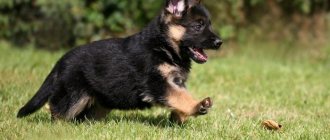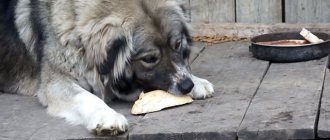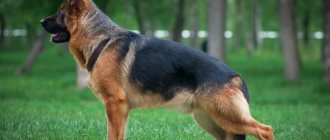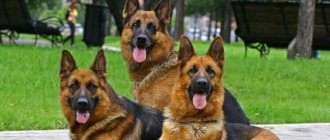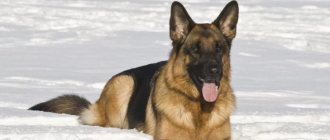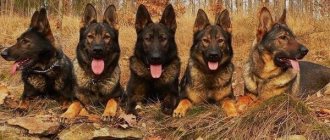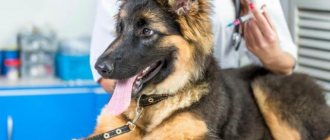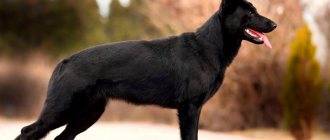History of the German Shepherd breed
German Shepherd
To trace the history of some breeds (for example, the Doberman and Airedale Terrier, which “come from” the 19th century, or the Old English Bulldog, bred in 1970), it is enough to refer to official documents and eyewitness accounts. With German Shepherds the situation is completely different. According to researchers, the beginning of the chain of their immediate ancestors should be sought in the depths of centuries.
Archaeological finds indicate that back in the 4th millennium BC, animals lived in the territory of modern Czech Republic, Poland and Germany, the skeleton of which has many features similar to shepherd dogs. These were the consequences of the evolution of wild individuals who chose to live near the sites of ancient tribes and became dependent on humans. It is assumed that even then a certain primitive selection was carried out, during which the largest and most obedient puppies were selected.
The now non-existent small Indian wolf increasingly moved away from its “free” relatives and gradually turned into the so-called Bronze Age dogs. Over time, people's needs have changed. Not only farmers, but also pastoralists were, to one degree or another, tied to a particular area. This means that the four-legged companions have new functions. In the Middle Ages, Hofwarts were bred throughout Europe. This German word is translated as “guardian of the yard,” but dogs were not only engaged in protecting real estate.
Domesticated cattle needed reliable protection from ruthless predators and hunters for other people's goods. Given the growing number of herds and flocks, it was simply impossible to cope with such a task with the help of shepherds. It was then that the yard dogs came to the rescue. Of course, not everyone was suitable for such work, but only the most savvy and resilient. They began to be selected and trained in a special way. And everything special is valuable, therefore, already in the 7th century, according to the laws of the ancient German Alemanni tribe, severe punishment awaited the culprit for the murder of a shepherd dog.
German Shepherd puppy
Of course, animals of the early Middle Ages, and even of much later eras, looked little like modern representatives of the breed. What was considered fundamentally important for the so-called primitive German shepherds was not the shape of the head and the position of the tail, but the corresponding intelligence, fairly large dimensions and a “psychological portrait”. The fact is that the lifestyle of shepherds implied long-term isolation; during the grazing season, the animals actually had contact exclusively with “their” person and had to not only obey unquestioningly, but also become good companions to him.
By the 18th century the situation had changed somewhat. Two regional types of German herding dogs took shape at once - the semi-long-haired Thuringian of a fawn-gray color with a curling tail and the long-haired Württemberg of a black or red color with semi-erect ears. They also differed in character: the former were called active animals, prone to loud and frequent barking, while the latter could boast of calmness and endurance. In the name of a common cause, breeders from the central and southwestern lands decided to join forces.
The result of the painstaking work of enthusiasts was presented to the general public only at the end of the 19th century. Baron von Knigge brought two of his pets, males Greif and Kiras, to the Hanover Dog Show in 1882. Later, interest in the new breed was fueled by the owners of the Hannau kennel, who showed the public an impressive pair - large and strongly built Pollux and Prima. It was thanks to them that almost two dozen champions and winners of exhibitions of subsequent decades were born.
In 1891, the creation of the first German Shepherd fanciers' society was announced. The Philax organization did not exist for long, but managed to approve the breed standard. The next significant event should be considered an exhibition in the small city of Karlsruhe on the German-French border. The event would have remained unnoticed by anyone if it had not been possible to see an outstanding representative of the old-format type. And not among the participants!
German Shepherd on duty
Hector von Lirkenhayn merely entertained visitors with a demonstration of herding skills. By a happy coincidence, retired military man Max von Stefanitz and his friend Arthur Meyer passed by, who devoted their free time to breeding German shepherds and immediately noticed the dog’s perfect external characteristics, in no way inferior to its working qualities. The owner, however, did not want to part with his pet so easily; negotiations took several weeks.
Having acquired the ideal “German”, von Stephanitz entered him as number one in the breeding book under a new name - Horand von Grafrath. At the same time, a large-scale search for females similar in type begins. The efforts were rewarded; in the litters received from Horand, a sufficient number of worthy successors of the breed were born. Most modern purebred lines are in one way or another connected with his son Hector von Schwaben, grandsons Pilot, Beowulf, Heinz von Starkenburg. The breeding of the black and yellow dogs recognizable today began with Hetel von Uckermark, son of Roland von Starkenburg. Another outstanding representative of the breed is Claudo von Boxberg, who won the international exhibition in 1925 and laid the foundation for new breeding lines.
Max von Stephanitz died in 1936. There is an opinion that this was indirectly facilitated by attacks from members of the National Socialist Party, who did not want the popularization of German shepherds outside Germany and even threatened the enthusiast with imprisonment in a concentration camp. During the Second World War, many nurseries were destroyed, many animals died, and no one cared about the purity of the blood of the remaining ones. But several valuable representatives of the breed were preserved, and in peacetime, von Stephanitz’s followers continued to work on the development of the breed. Exhibitions resumed in 1946, and five years later a new hero appeared at one of them - champion Rolf von Osnabrücker, the founder of modern “high breeding” lines.
Back in April 1899, the German Shepherd Owners' Union was created. The activities of von Stephanitz, Meyer and other leaders were aimed mainly at maintaining the purity of the blood, which would be confirmed by relevant documents, encouraging outstanding breeders and developing the working qualities of the breed. The organization still exists today, and in May 1968 an international association was founded, which today is known as the World Union of German Shepherd Associations and unites 89 national unions from 82 countries.
Basic moments
- German Shepherds can be both service dogs performing security or detection functions, and companions for families.
- Loyal and flexible pets unquestioningly recognize the authority of the owner.
- German Shepherds are one of the top three smartest dog breeds (along with border collies and poodles).
- They need human company and physical activity.
- They get along well with children of all ages.
- They are able to live not only indoors, but also in an enclosure.
- The average life expectancy of a German Shepherd is 9-13 years; after 7 years, strict health monitoring is required.
Appearance of a German Shepherd
German Shepherds are medium in size. The height of a male dog at the withers is 60-65 cm, weight 30-40 kg, females are 5 cm lower and 8 kg lighter. The proportion of height and weight is important. The dog is slightly elongated, strong and muscular, strongly built, but the bones are not rough.
Head
German Shepherd muzzle
The length of the head is 40% of the height of the dog at the withers. The shape is wedge-shaped, but not too elongated, moderately wide between the ears. The forehead is slightly convex. The ratio of the cranial and facial parts is 1:1. The transition between them is expressed smoothly.
Neck
The German Shepherd has a neck length approximately equal to the length of its head. Strong and muscular, very agile.
Eyes
Oval in shape, slightly obliquely spaced, not convex, medium in size. The color is dark.
Nose
Classic shape, without a clear dividing strip. The nose is black.
Teeth and jaws
The upper and lower jaws of the German Shepherd are well developed. The teeth are strong, the dental formula is complete. The lips fit tightly to the jaws. Scissor bite.
Ears
The ears of the German Shepherd are large, erect, triangular in shape, and directed parallel. The ears are open forward. The ear cartilage is elastic, without creases or bends.
Torso
The chest is long, wide and deep. The line of the back goes downward from the withers to the croup. The withers are strong, the back is wide and strong, the croup is sloping, with an imperceptible transition to the base of the tail.
German Shepherd in profile
Tail
The tail of German Shepherds is relatively long, slightly curved, and in its normal position it hangs down. Fluffy, with longer hair on the lower part of the tail.
Limbs
Black German Shepherd
The front legs are straight, parallel when viewed from the front. Strong and muscular. The shoulder blades and humerus are the same length and connect at right angles. The hind legs are slightly set back, straight and parallel when viewed from behind. The thigh and lower leg are of the same length, connected at an angle of 120°. Strong and muscular. The front paws are rounded and the toes are arched. The hind feet are compact, the toes are lightly arched.
Wool
Double coat, with thick, straight, coarse topcoat and dense undercoat.
Color
Black with reddish-brown, brown, yellow to light gray tan markings. Solid black or solid grey. Zoned gray shepherds display a black saddle coat and mask.
What does a purebred German look like?
German dogs of pure blood have a developed muscular corset , a dry skeletal system and are of average height and straight paws. The coat color varies from black to brown with various patches. Dogs come in long-haired and short-haired varieties. The muzzle is cone-shaped, strong, the jaws are powerful, the eyes are small.
Photo of an adult German Shepherd
Personality of the German Shepherd
Without exception, all owners of German Shepherds call them loyal, intelligent, calm and obedient animals. The key to an excellent character is the animal’s stable psyche and proper upbringing.
Shepherd dog with its owner
The high intelligence of Germans is not accompanied by a desire for independence and stubbornness; they easily and with pleasure master new games, teams, and territories. Dogs do not like loneliness, but they patiently wait for their owner to return. For a good mood and normal well-being, they urgently need human society, including long walks and active games.
One of the important features of the German Shepherd remains its innate protective instincts, therefore they are wary of strangers in the home and even during a walk, although they never show aggression without a reason. The devotion to the owner and family of these pets is raised to the degree of absolute; they are ready to sacrifice themselves, protecting their household from danger, and they assess the degree of danger instantly and adequately.
German Shepherds love children and enjoy playing with them. However, it is not recommended to leave babies alone with a dog, if only because of the difference in size and weight. The shepherd is tolerant of other animals in the house; friendly relations are possible if they grow up together.
Future defender
How character changes
To raise a healthy and psychologically stable dog, in addition to weight, you need to worry about its socialization and education. In the life of a puppy, there are several important stages of character change that every self-respecting breeder should know about.
German Shepherd training
- 2 months. Introducing the puppy to its new family. At this time, the shepherd's learning ability is at a high level, so the owner should start teaching basic commands. At this time, puppies are quite vulnerable, so any training should be accompanied by love and patience. If the puppy does not obey, he should be punished as his mother would have done it. To do this, the owner must take the puppy by the withers and press him to the floor, saying the command “fu!” When it comes to socialization, it can be helpful to give your pet the opportunity to interact with other dogs.
- 4 months. This stage implies the formation of a hierarchy. If a puppy starts biting or grinning, he is trying to determine who is in charge in the family: the owner, his family members, or him. It is important for him to understand that he is on the lower rung after his family. Lack of proper upbringing will allow the puppy to take a leading position, which will have a negative impact in the future.
- 5 months. The main tasks of this period are training and proper education. Males may begin to show the first signs of heat by jumping on their feet. If the dog is planned to be used for breeding, you cannot scold for these movements; it is better to carefully distract the puppy with a toy.
- 6 months. The time for self-assertion of a raised shepherd dog. Owners may encounter reluctance to follow commands and other disobedience on the part of the pet. In this case, you should behave calmly and try to prevent possible antics. It is also important to give the dog enough attention.
- 7-12 months. Dogs often become fearful or nervous in situations that were previously familiar to them. This behavior is not caused by genetic predisposition or errors in upbringing; it is a natural stage in the development of an adult shepherd dog.
- 1-4 years. Time for the final formation of character and protective instinct.
Important! Each stage requires a competent approach. Proper upbringing and care from the owners will turn the puppy into a devoted friend and guard.
Education and training
As mentioned above, German Shepherds are intelligent and easy to train animals. But raising a large dog should never be left to chance. From the first months of life, in the form of interesting games and tasks, the completion of which is accompanied by receiving treats, the puppy receives an understanding of acceptable norms of behavior and important commands.
German Shepherd with a child
The owner should demonstrate his authority without resorting to shouting and, especially, physical force. If it seems to you that there are significant deviations in the puppy’s behavior that you cannot cope with yourself, be sure to seek help from a canine specialist.
Of course, not every German Shepherd becomes a service dog and maintains order in special units. But even a pet needs to understand and respond adequately to basic commands: “Come to me!”, “Place!”, “You can’t!”, “Nearby!”, “Sit!”, “Lie down!”, “Walk!”, “ Aport!
When the puppy’s bones are strong enough, you can begin to overcome obstacles (be sure to take into account the height and capabilities of the pet). The most important point is to teach the dog to walk on a leash, and from six months - in a muzzle. It’s better to do this gradually and don’t forget about tasty rewards for obedience.
It is important to remember that German Shepherds reach psychological maturity quite late, by the age of three. A young dog, whose dimensions fully correspond to the breed standard, internally remains a vulnerable puppy, requiring care and approval.
What to do if a German is behind the norm
You should not panic if a young dog, whose age does not exceed three years, is 10-15% behind the standard in weight or height. Each dog develops according to an individual plan. A German Shepherd that continues to grow often experiences underweight due to rapid, spasmodic development. To minimize the consequences of the lag, the diet should be reconsidered, increasing the content of protein (meat, fish, offal) and fermented milk products (kefir, cottage cheese).
To gain muscle mass, you should devote more attention and time to training your dog and playing outdoors. For this purpose, a special program is developed, designed for a specific individual. From breeders you need to find out details about the pet’s parents, how they developed and make sure that there are no genetic diseases in the family that affect the height and weight of the offspring. Perhaps the puppy belongs to a breed line with late maturation, which is also something a dog breeder should know about.
If your dog does not weigh enough for his age, you should not overfeed him or use drugs to gain muscle mass. Excessive exercise can negatively affect the health of your German Shepherd. Only with a balanced diet, regular physical exercise, and the absence of pathologies will the dog gain the desired weight without additional effort.
Care and maintenance
The structural features of the coat allow the German Shepherd to live both indoors and in the yard. In the second case, a spacious enclosure with an insulated booth is needed. In addition, it is advisable to at least partially protect the enclosure from precipitation and wind.
German Shepherd having a meal
Immediately after the dog appears in the house, determine for it its own place where there will be bedding, a mattress, and toys. There should be no direct sources of heat or drafts in its immediate vicinity. Natural materials that do not require complicated cleaning are preferred for the bed. A sufficient number of toys will protect furniture and shoes from sharp teeth.
The main aspect of proper maintenance of any dog is a balanced diet, which will ensure normal development and good health for life. The easiest way to guarantee a complete diet is ready-made premium and super-premium food for the appropriate age category, and for adult animals - taking into account special needs. With a “natural” diet, it is important to follow the ratio of protein products and fiber recommended by veterinarians. And, of course, you cannot feed your shepherd dog scraps from the human table, because its digestive system is not ready to work with fatty, fried, salty foods and spices. Fresh water must be available at all times.
When soiled (but not too often), it is necessary to bathe the dog in warm water with special shampoos. Brushing is carried out once or twice a week; during seasonal molting, the procedure must be done more often. The condition of the ears, eyes, mouth, and nasal passages should be regularly monitored.
It is recommended to visit the veterinarian for a preventive examination at least 2-3 times a year.
Ideal performance
How much does an adult German Shepherd weigh?
How much should a puppy weigh? These are very real questions for new dog owners. Since the breed is large, its weight indicators are also quite significant. And the ideal at each stage of development is different, it will be indicated in the table below. It’s generally not easy to give a specific figure here, since the norms differ by gender and type of dog . Simply put, there is simply no ideal. Slight deviations in one direction or the other are acceptable. The average weight of a German Shepherd (males of this breed) is approximately 35 kg, females - 27 kg.
German Shepherd Health and Diseases
The average lifespan of a German Shepherd is 9-13 years.
Difficulties in forming the breed and forced inbreeding have led to a number of serious diseases. Some appear in puppyhood: growth hormone deficiency, diabetes, leukemia, eosinophilic panostitis (intermittent claudication), intussusception, pyoderma (purulent skin lesions).
Later, allergies, hip dysplasia, intervertebral disc diseases, arthritis, corneal dystrophy, epilepsy, cataracts, pancreatic insufficiency, dysplasia of the tricuspid or mitral heart valve, aortic stenosis (narrowing of the opening of the vessel), exudative pericarditis (inflammation of the outer membranes of the heart) may appear. , cancer, hind limb paralysis.
Under the influence of external factors, ear and eye infections, dermatitis, volvulus, bloating and others can begin.
At the first signs of poor health, you should contact a veterinary clinic, where they can make a correct diagnosis and begin treatment. In addition, it is important to see your veterinarian regularly for routine check-ups - especially for puppies in active growth and dogs over 7 years of age.
Puppy weight and sizes for male and female by month from 1 to 12 months (table)
| Age by month | Height at withers for males (cm) | Height at withers in bitches (cm) | Weight for males (g) | Weight in bitches (g) |
| 1 month | 20-21 | 19-20 | 3.500-4.200 | 3.000-3.300 |
| 2 months | 35-38 | 32-35 | 8.500-9.000 | 7.500-8.000 |
| 3 months | 44-48 | 40-44 | 14.000-14.200 | 12.000-12.300 |
| 4 months | 52-57 | 47-52 | 19.000-20.000 | 16.000-16.400 |
| 5 months | 54-58 | 51-54 | 22.000-22.900 | 20.000-21.700 |
| 6 months | 56-60 | 52-56 | 24.000-26.000 | 22.500-23.000 |
| 7 months | 57-61 | 53-57 | 28.000-28.400 | 23.000-24.700 |
| 8 months | 57-61 | 53-57 | 29.000-30.000 | 25.000-25.200 |
| 9 months | 57-61 | 53-57 | 30.500-32.000 | 26.100-26.500 |
| 10 months | 58-62 | 54-58 | 32.900-33.300 | 27.000-27.500 |
| 11 months | 58-62 | 54-58 | 33.000-33.500 | 28.000-29.000 |
| 12 months | 59-63 | 55-59 | 33.000-34.000 | 30.000-32.000 |
How to choose a puppy
The above-mentioned features of appearance and character apply to purebred German shepherds, that is, to those whose pedigree has been confirmed by official documents over several generations.
Half-breeds can certainly be wonderful and loyal pets, but they are still completely different dogs. Future owners who are interested in a specific breed should look for a puppy only from trusted breeders and kennels with an excellent reputation. This way you can be sure of the absence of genetic diseases and the “trademark” mental stability that is so important for a large pet.
Responsible breeders do not sell puppies to buyers who are less than 8-10 weeks old. By this time, the little German is already confidently standing on his paws, responding to his own name and is ready to begin training.
If a dog is purchased not for breeding and participation in exhibitions, the main selection criteria are its health and friendliness. Indicators of the first are considered to be a good appetite, playfulness, clear eyes, nose and ears, shiny coat, and an elastic belly without signs of bloating. A young German Shepherd should not be afraid of calmly behaved people or react aggressively to attempts to approach.
It is also better to “get to know” the parents in order to have an idea about the heredity of the future pet, and to look at the living conditions of the mother and the babies. Cleanliness, sufficient space, quality food and toys, timely vaccination are undoubted evidence in favor of the breeder.
When teeth change
Puppies have 28 baby teeth, which from 3 months will begin to change to permanent molars. After complete replacement, an adult shepherd dog has 42 teeth, 22 of which are in the lower jaw and 20 in the upper jaw.
Note! The period of active tooth change can cause the animal to feel slightly unwell or have an increase in body temperature. The incisors are the first to change, followed by the canines. To speed up the process of changing them, you can let your puppy chew hard treats and special toys.
Correct dog bite
Natural teeth cleaning is facilitated by the shepherd eating hard carrots, crackers, apples and special bones. But despite this, to maintain the health of your teeth, it is recommended to clean them yourself. Stores sell pastes and brushes designed for oral care in dogs.
The German Shepherd is deservedly considered one of the smartest breeds. She has valuable working qualities that are used during service at the border, in security and other services. And, of course, “Germans” are excellent guard dogs and loyal friends. In order for the family to have just such a shepherd, it is necessary not only to monitor its weight, but also to competently work on its upbringing and character development.
Photos of German Shepherd puppies
How much does a German Shepherd cost?
Potential show winners with impeccable breed standards and “champion” pedigree will not cost less than a thousand dollars.
They are usually sold at the age of 5-6 months, or even older - when external characteristics have already been formed and they even have experience of participating in junior “shows”. Purebred German Shepherd puppies, which do not qualify for international recognition due to certain formal shortcomings, but can become excellent service and guard or family dogs, are sold in kennels for prices ranging from 300 to 900 dollars.
Dogs without a pedigree are significantly cheaper, but in this case no one guarantees you either external or psychological compliance with the idea of a real German Shepherd.
Show dog and its condition
Having got an ideal pedigree dog, you may not get a good mark at the show. Education and training are only one part of the job. The dog must have the correct constitution, that is, normal grooming and fatness. A well-fed pedigree dog will not receive a good grade, just like an emaciated one. The condition of a pedigree dog, as a rule, differs from this indicator of an animal of working breeding. The latter may have a thinner layer of fat. Working dogs are not assessed by conformation at all, since their success in competitions is important. They are used to evaluate the dogs in this ring.
The two branches of dogs have been bred since the time when the kennel owners themselves split. Some focused on beauty, others on reaction speed and endurance. At the same time, pedigree dogs still did not become decorative sissies.


